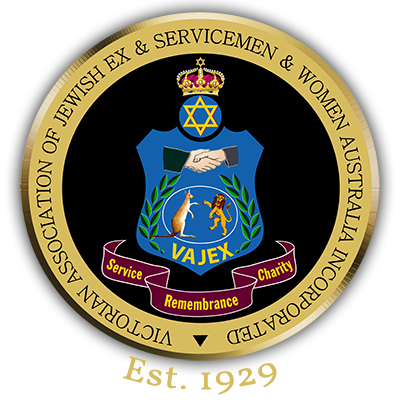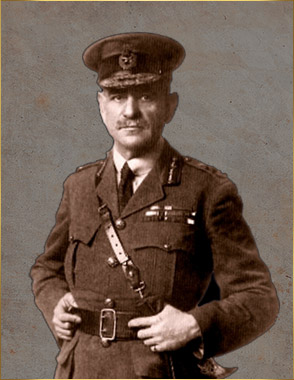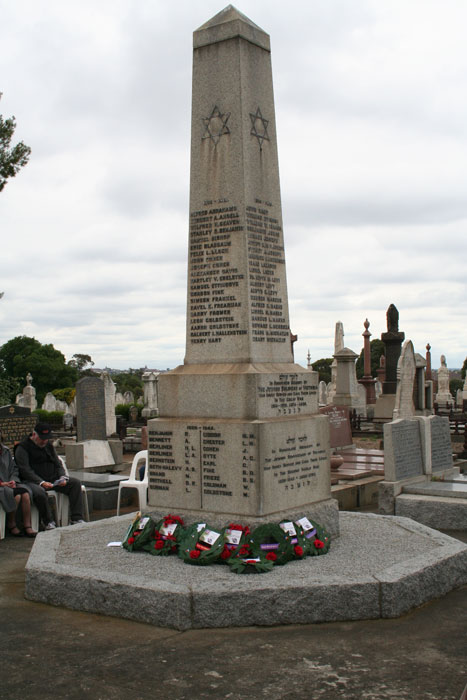Victorian Association of Jewish Ex & Servicemen & Women Australia Incorporated
Founding Member General Sir John Monash GCMG KCB VD
Barnard
Surname
Barnard
First names
Sydney Harry
Rank
Private
Service No.
6762
Date of Death
3/05/1918
Hebrew Date
21 Iyyar 5678
Hebrew Date
כ״א בְּאִיָּר תרע״ח
Age at Death
38
How Died
Killed in Action
Where Died
France
Cemetery
Villers-Bretonneux, France
Service Details
48th Australian Infantry Battalion, AIF
Served
Western Front
Occupation
Head salesman
Age at Enlistment
36
Place of Enlistment
Adelaide, South Australia
Locality on Enlistment
South Australia
Religion
Jewish
Gender
Male
Date of Enlistment
16/6/1916
Date of Discharge
Country of Enlistment
Australia
Notes
Sydney Barnard was born on 19 October 1879 in North Adelaide, South Australia; he was the son of Simeon BARNARD and his wife Jannetta (Janelle) née LEE. Sydney had a younger brother, Lancelot, who had enlisted back in January 1915. Sydney joined the AIF in Adelaide on 16 June 1916, at the time he gave his occupation as Head Salesman. He was nearly 37 years old when he enlisted; he was 5ft 7 inches tall, weighed 150lbs and had brown eyes and dark hair, he gave his religion as Jewish. On enlistment, Sydney joined “A” coy of the 2nd Depot Infantry Base. Being much older than the average recruit and hence perceived to be more mature, Sydney was appointed Corporal to the Company. Training got underway and on 7 July, Sydney was sent to the Army’s South Australian School of Musketry at Cheltenham. Sydney went on to attend the Non Commissioned Officers School at Mitcham. On returning to the 2nd Depot, he was appointed Provost Sargent with “A” Coy, no doubt his maturity was valued and his appointment helped to maintain good order within the company. On 25 October, four months after joining, Sydney was sent to attend the Officers School of Instruction; he was to remain there until 15 December returning once again to “A” coy as Provost Sargent. On 1 August 1917, Sydney transferred to 27th Battalion as part of their 20th Reinforcements; here he also held the appointment of Provost Sargent. Sydney’s brother, Lancelot, was already serving with the 27th Battalion in France. On 27 October 1917, Sydney and the other men of the 20th Reinforcements entrained for the 3rd Military District (Melbourne). The train trip would take two days. They arrived on 29 October and embarked on 30 October at Port Melbourne, on board the A6, HMAT "Aeneas" bound for England. Sydney was appointed Acting Sargent for the duration of the voyage. After a four week voyage, the ship arrived at Devonport in England, the troops disembarked on 27 December. They were then transported to the Military Camp at Fovant in Wiltshire. On 30 December, Sydney and the other men of the 20th Reinforcements marched in to 6th Training Battalion at Fovant, Sydney reverting to the rank of Private. The men settled into prefab wooden huts with corrugated iron cladding and roofs and a wood burning stove in the centre of the hut. Each hut provided accommodation for 30 men. The Camp was well laid out and provided the men with access to a cinema, YMCA, Post Office, hospital and sporting facilities. In August 1916, the London Rifle Regiment began carving its regimental badge into the chalk on the hillside overlooking the Camp, soon other regiments also started to carve their regimental badges and not to be left out, so did the Australians. Sydney would have seen this work being undertaken and perhaps at some time during his three month stay in the camp, he may have joined the other Australians troops as they strove to carve out the largest badge, the Australian Rising Sun Badge that even today measures 51m x 32m. Sydney was appointed Acting Lance Corporal on 4 January 1918. The men trained in the challenging landscape of the Downs. They learnt to dig trenches, lay barbed wire, run communications cables, basic field movement and night operations, all combined with route marches, bayonet drill, machine gun training and marksmanship. There was much to learn over the three months they spent with the Training Battalion. On the 31 March 1918, Sydney transferred to the 48th Battalion, reverting once again to the rank of Private. The same day he proceeded overseas via Dover for service on the Western Front. On 1 April, Sydney marched in to No 1 Overflow camp at Calais, five days later he marched out to join the 48th Battalion in the field. The 48th Battalion was out of the line and resting when Sydney was officially taken on the strength of the Battalion on 13 April and he was assigned to “B” Coy. The Battalion was at Beaucourt about 18kms from Amiens, they had been in heavy fighting that had taken out many of their Lewis gunners and they were now training volunteers to fill the gaps. Sydney volunteered. The Battalion got to work digging trenches and strong points to house the Lewis guns as reports indicated that enemy attacks were imminent. Dug in, they waited in the pouring rain, they were reinforced by the 32nd Battalion which helped bolster the troops holding the position. Training for the volunteer Lewis gunners went on relentlessly and the Battalion commander was very pleased with the excellent progress that was being made. On 24 April, the German Heavy Artillery laid down a heavy barrage, an attack was underway all along the line, the Germans had broken through part of the line at Villers Bretonneux and the 48th Battalion was to move to reinforce the line. On Anzac Day, 25 April, the Battalion moved to Pont Noyelles were they waited in reserve for two days, later they moved to Cachy Switch near Villers Bretonneax, it was a long walk to the front line but the men took up their positions by 12.25am and at first light they started improving their positions as they came under artillery fire. Sydney and the Battalion remained in the area under fire, until the beginning of May when the decision was made to launch an attack on Monument Wood. At 11.30pm on 2 May, the Battalion moved off by Companies to the “jumping off” line, by 1.45am they were in position, two companies led by “B” coy, were moving north to south. At 2am, the artillery barrage commenced at 2.02am the men moved off, the enemy returned vigorous fire. It was during the charge to capture the enemy trenches that Sydney was killed. The official report of Sydney’s death reads “At 2.15am on 3rd May 1918 at Villers Bretonneax, he (Sydney Barnard) was advancing with a Lewis Gun Team and when close to the enemy trenches, he was killed by a burst of machine gun fire. He was taken to the rear and buried. No map reference recorded”. Although Sydney was buried by his comrades, there is no indication of his final resting place. Sydney is still remembered, his name is recorded amongst the more than 11000 names on the Australian National Memorial at Villers Bretonneax to those who have no known grave. Back in Australia, Sydney’s family were advised of this death which was greeted great sadness. In August a package was received by his father, it contained some of Sydney’s personal effects. A notebook, 5 school of instruction certificates, 7 bank withdrawal forms, a card and some photos. In January 1919 a further package would arrive containing, a holdall, air pillow, housewife, 3 chevrons and 3 handkerchiefs.Sydney’s brother Lancelot was wounded in France but survived the war. For his service during the war, Sydney was awarded the British War Medal and The Victory Medal, they along with the Memorial plaque and scroll were presented to Sydney’ father Simeon.

 John Monash (Monasch) born
in Melbourne, Australia on 27 June 1865, the son of
German Polish Jewish migrants, can be researched in any
military history encyclopaedia or in fact by just
‘Googling’ his name on the internet. His history
and list of achievements are long and far too many to detail
in this brief summary. However, might I say that reading his
history is well worth the effort and I can assure you that
his deeds will amaze you. I have found that the deeds are
better labelled on more than one man and in more than one
lifetime.
John Monash (Monasch) born
in Melbourne, Australia on 27 June 1865, the son of
German Polish Jewish migrants, can be researched in any
military history encyclopaedia or in fact by just
‘Googling’ his name on the internet. His history
and list of achievements are long and far too many to detail
in this brief summary. However, might I say that reading his
history is well worth the effort and I can assure you that
his deeds will amaze you. I have found that the deeds are
better labelled on more than one man and in more than one
lifetime. An
announcement was made in the weeks leading up to the
Centenary of ANZAC by Judy Landau, President VAJEX Aust.
She stated that it gave her great delight to announce
that VAJEX Aust (Victorian Association of Jewish Ex
& Servicemen & Women Australia Inc) has
successfully raised the required funds to build a new
Victorian Jewish Memorial after the style of the
historic Memorial located in the Jewish section of the
Melbourne General Cemetery. After an extensive two year
process, Judy has single-handedly sought letters of
support, raised the funds, and obtained approval from
the City of Port Phillip.
An
announcement was made in the weeks leading up to the
Centenary of ANZAC by Judy Landau, President VAJEX Aust.
She stated that it gave her great delight to announce
that VAJEX Aust (Victorian Association of Jewish Ex
& Servicemen & Women Australia Inc) has
successfully raised the required funds to build a new
Victorian Jewish Memorial after the style of the
historic Memorial located in the Jewish section of the
Melbourne General Cemetery. After an extensive two year
process, Judy has single-handedly sought letters of
support, raised the funds, and obtained approval from
the City of Port Phillip.
